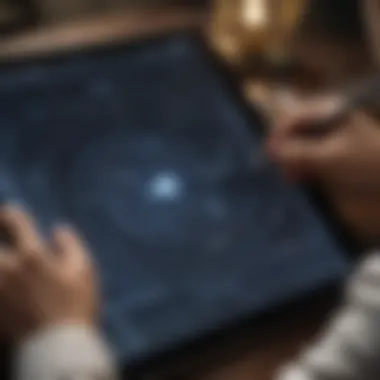Free Star Charts for Specific Dates: A Comprehensive Guide


Intro
The study of astrology has captivated human curiosity for centuries. One of its key components is the creation and interpretation of star charts. These charts represent the positions of celestial bodies at specific moments in time, and can provide insight into personality traits, relationships, and even decisions in everyday life. Understanding how to generate free star charts for various dates can be an invaluable tool for both novices and experienced astrologers. This article aims to illuminate the process of accessing and creating these star charts, while discussing their relevance in astrology.
Astrology firmly interconnects with human experience, relating cosmic events to personal and global phenomena. Consequently, the significance of accurately reading star charts cannot be understated. The following sections will delve into the nature of zodiac profiles, compatibility insights, and astrological events, thus framing a well-rounded narrative to enhance your understanding of how the stars influence life.
Zodiac Profiles
Overview of Each Sign
The zodiac comprises twelve distinct signs, each corresponding to a segment of the celestial sphere. These signs are:
- Aries (March 21 - April 19)
- Taurus (April 20 - May 20)
- Gemini (May 21 - June 20)
- Cancer (June 21 - July 22)
- Leo (July 23 - August 22)
- Virgo (August 23 - September 22)
- Libra (September 23 - October 22)
- Scorpio (October 23 - November 21)
- Sagittarius (November 22 - December 21)
- Capricorn (December 22 - January 19)
- Aquarius (January 20 - February 18)
- Pisces (February 19 - March 20)
Each sign carries its own unique characteristics and attributes. These profiles serve as the foundation for constructing personal horoscopes that reflect one's placement in the cosmos.
Personality Traits
The personality traits associated with zodiac signs offer insights into individual behaviors and tendencies. For instance, Aries is often viewed as energetic and assertive, while Pisces is considered intuitive and compassionate. Understanding these traits can assist in personal development and interpersonal dynamics.
Strengths and Weaknesses
Every sign possesses strengths and weaknesses. Knowing these attributes is crucial for navigating life better.
- Aries: Strength – Leadership; Weakness – Impulsivity
- Taurus: Strength – Reliability; Weakness – Stubbornness
- Gemini: Strength – Adaptability; Weakness – Inconsistency
Recognizing these traits may enhance insights into personal challenges and reinforce beneficial qualities.
Compatibility Insights
Love and Relationships
Relationships often benefit from astrological understanding. Zodiac compatibility can help explain attraction and potential friction between partners. For instance, fire signs like Leo often match well with air signs such as Libra.
Friendship Compatibility
The dynamics of friendships can also be influenced by astrology. Friendships may thrive when compatible signs come together, leading to nurturing relationships that withstand time.
Workplace Dynamics
In a professional setting, understanding zodiac compatibility can pave the way toward effective teamwork, reducing conflict and enhancing cooperation.
Astrological Events
Monthly/Weekly Horoscope Breakdown
Astrological events vary on a monthly or weekly basis, influencing individual experiences. By consulting daily or weekly horoscopes, astrologers can better grasp these shifts.
Notable Celestial Events
Celestial events, such as eclipses or planetary alignments, hold significant meaning in astrology. These occurrences create waves of influence, shaping collective and personal experiences.
How to Prepare for Astrological Shifts
Preparation for these events can enhance adaptability and resilience. Keeping a personal journal to track feelings and experiences during these cosmic changes can provide clarity.
"Astrology is a language. If you understand this language, the sky speaks to you." – Dane Rudhyar
Astrology, through the creation of star charts and understanding zodiac profiles, compatibility, and events, opens paths to exploration and richness in personal and communal experiences. As this article unfolds, a deeper understanding of the cosmos will bloom, inviting an engaged readership to learn how astrology can enhance various aspects of life.
Understanding Star Charts
Understanding star charts is crucial for anyone interested in astrology and its mystical connections to our lives. Star charts provide a visual representation of where celestial bodies are located at a specific moment, such as a person’s birth date or a significant event. These charts help in interpreting how planetary positions influence human behavior, emotions, and life events.
By examining the arrangement of stars and planets, astrologers can gain insights into personal traits, relationships, and even possible future developments. This understanding allows individuals to approach their lives with greater awareness of the broader cosmic influences at play. Considering these factors can enhance one's practice, making personal decisions more aligned with astrological insights.
Definition of Star Charts
A star chart, or natal chart, is essentially a map of the sky at a specific time and place. It includes the positions of the Sun, Moon, planets, and other astrological points, drawn on a two-dimensional plane. Each chart consists of twelve segments, known as houses, which correspond to different life areas. This is important for understanding how various celestial influences manifest personally.
Astrologers interpret star charts by analyzing the placement of zodiac signs, the angles between planets, and the aspects they form with one another. This systematic representation allows for a more organized approach to astrology, making it easier to draw conclusions that can impact life decisions.


Historical Context and Evolution
The use of star charts dates back thousands of years, with roots tracing back to ancient Babylonian astronomy. The Babylonians understood the significance of celestial events and began recording them systematically. Over time, these early star charts provided a foundation for astrological thought, gradually evolving through Egyptian and Greek influences.
As the discipline progressed, methods of chart creation became more sophisticated. During the Renaissance, significant advancements occurred in understanding planetary movements and their meanings. This historical evolution helped separate astrology from astronomy, leading to the intricate practices we have today. Modern technology has further transformed how star charts are created, allowing enthusiasts to easily access detailed charts online, making astrology more accessible than ever before.
"Astrology is a bridge between heaven and earth, helping us navigate our lives with greater awareness of the celestial influences."
Importance of Specific Dates in Astrology
The significance of specific dates in astrology cannot be overstated. Astrologers often emphasize that the alignment of celestial bodies captures unique energies on given days. This cosmic interplay becomes particularly pertinent during critical life events, guiding individuals in decision-making and understanding personal influences.
The Role of Birth Dates
Birth dates form the core of an individual's astrological identity. A natal chart, derived from the exact date, time, and location of birth, provides insights into a person’s characteristics and life path. This chart serves as a foundation for personalized interpretations, revealing inherent traits and likely paths in life. Often, astrologers will return to one’s birth date to assess current influences from transits and progressions, making it essential for anyone looking to understand their astrological profile more deeply.
Planetary Alignments and Their Significance
Planetary alignments on specific dates can dramatically alter the energies perceived by individuals. For instance, a conjunction of Jupiter and Saturn is known to mark a period of opportunity and growth. Each planet carries its energies, which interact with personal birth charts when they transit through specific signs or houses. Tracking these alignments can provide guidance on when to act or be cautious. The timing of significant events, such as eclipses or retrogrades, needs careful attention, as they hold considerable potency in shaping experiences.
Celestial Events and Their Impact on Specific Days
Celestial events, such as meteor showers, eclipses, or full moons, also influence specific days in distinctive ways. These occurrences are not merely astronomical phenomena; they offer profound insights and timing for activities ranging from planting new endeavors to making realignments in life. Each event carries a unique resonance that can affect emotions, relationships, and personal aspirations. Understanding how these events interact with one's natal chart can assist in leveraging their potential, as many practices in astrology revolve around enhancing one’s life according to cosmic rhythms.
"Astrology is the study of the correlation between the cosmos and human experience, allowing deeper connections to the universe."
In summary, recognizing the importance of specific dates in astrology enriches one's understanding of personal and collective experiences. By exploring the role of birth dates, planetary alignments, and celestial events, individuals can gain valuable insights into how these factors influence their lives.
Types of Star Charts
Understanding the different types of star charts is fundamental in astrology. Each star chart serves a unique purpose, making it crucial for astrology enthusiasts to know which chart to use for their specific needs. Depending on what an individual wants to explore—whether it is personal insights, transits influencing current events, or future progression—different charts can provide tailored information. This section will explore three primary types of star charts: natal charts, transit charts, and progressed charts. Each type illuminates various aspects of astrology, helping users derive more precise insights.
Natal Charts
Natal charts are often regarded as the cornerstone of astrological practice. These charts are created based on the exact date, time, and location of an individual's birth. In essence, they reflect the positioning of celestial bodies at that particular moment. A natal chart can reveal a lot about a person's character, strengths, weaknesses, and life path.
Some key elements of natal charts include:
- Sun Sign: Represents core identity.
- Moon Sign: Indicates emotional nature.
- Rising Sign (Ascendant): Offers insights into outward behavior.
Understanding these components helps individuals gain deeper self-awareness. Many practitioners rely on natal charts to analyze personality traits, making them valuable tools for personal growth.
Transit Charts
Transit charts focus on the current positions of planets and how they interact with the natal chart. These charts help astrologers assess how ongoing planetary movements influence a person's life at any given time. Transits may signal important changes or opportunities, and understanding them can provide guidance during pivotal events.
Astrologers often assess the following with transit charts:
- Major Transits: Notable planetary movements, like Saturn returns or Jupiter’s expansion.
- Challenging Transits: Times of tension that might require careful navigation.
By analyzing these transits, individuals can prepare for future challenges and seize opportunities presented by planetary alignments.
Progressed Charts
Progressed charts take into account the evolution of a natal chart over the years. They essentially illustrate how a person's astrological influences change as they age. Astrologers create progressed charts by advancing the natal chart forward, often using one day of progression for each year of life.
This type of chart provides insights into:
- Life Phases: Different periods in a person’s life where certain energies become more pronounced.
- Development: How one grows and evolves over time, highlighting personal milestones.
Progressed charts are beneficial for long-term planning and introspection, offering a roadmap of sorts for future decisions.
In summary, knowing how to use each type of star chart is vital for anyone serious about astrology. Whether examining natal, transit, or progressed charts, each offers unique insights that can enhance awareness, understanding, and decision-making in life.
How to Generate Free Star Charts
Generating star charts for specific dates can be an enlightening practice for anyone interested in astrology. The ability to create these charts without incurring costs opens doors for beginners and seasoned astrologers alike. Understanding how to generate free star charts lets users follow their celestial events, track planetary movements, and analyze their implications on personal lives. This section will provide clarity on several avenues for creating these charts, focusing on online resources, mobile applications, and software that cater to diverse needs.
Online Resources and Tools
The internet offers a plethora of platforms for generating star charts at no cost. Websites like AstroSeek, Astrodienst, and Sky & Telescope are among the most popular. These online tools are user-friendly and cater to both novice and experienced users. They generally require the input of data such as your birth date, location, and desired astrological aspects. Once this information is entered, the tool can generate a personalized star chart.


The benefits of using online resources include access to educational content about chart interpretations. Many sites offer guides to help users understand how to read charts and what different elements, such as houses and planets, indicate.
When using free tools, consider the following:
- Privacy: Some sites may request personal information. Ensure their privacy policy aligns with your comfort levels.
- Range of options: Different sites might offer distinct features, such as detailed interpretations or multiple chart styles.
- Updates: Some tools may require updates to maintain accurate astrological data, so check the site for the latest versions.
Mobile Applications for Star Chart Generation
Mobile applications have gained popularity for their convenience and ease of use. Apps such as Co–Star, TimePassages, and The Pattern bring star chart generation into the palm of your hand. Users can generate charts on the go, making it accessible for quick reference or more in-depth analysis at any time.
These applications often provide daily horoscopes that are personalized based on the user's birth chart. They create a daily experience that incorporates individual astrological insights. Additionally, many apps include social features that allow users to explore compatibility with friends and family, adding another layer of personal engagement.
While mobile applications are useful, one must be aware of:
- In-App Purchases: Some features may only be available through premium purchases.
- Battery Drain: Using astrological apps can sometimes consume a significant amount of battery, especially if the app utilizes location services to generate accurate charts.
- Distractions: Notifications from these apps can sometimes pull users away from a focused study.
Software Options for Deep Analysis
For those looking for a more in-depth analysis of their star charts, specialized software such as Solar Fire or AstroGold is available, though often for a purchase fee. Some versions may offer trial periods, allowing users to explore functionalities before committing.
These software applications offer advanced features like:
- 3D Planetarium View: Visualizations of planetary movements provide a unique perspective on celestial activity.
- Extensive Database: Access to a broader range of astrological data over time.
- Customization: Options to create unique charts based on various astrological techniques.
Take note of the learning curves associated with more complex software. There could be initial challenges in understanding functionalities and features, but the potential insights gained can be significant.
"The beauty of free star chart generation lies in its accessibility, offering a pathway for those seeking to connect with astrological influences without financial burdens."
In summary, whether utilizing online resources, mobile apps, or dedicated software, every option has its own advantages and considerations. Choosing the right method hinges on individual preferences, needs for depth, and context of use.
Interpreting Star Charts
Interpreting star charts is a critical aspect of understanding astrological concepts and their implications on human experience. By analyzing these charts, individuals can uncover insights about their personality traits, potential life challenges, and significant opportunities. This section will delve into fundamental elements of interpretation, emphasizing the roles of zodiac signs, planetary influences, and the houses of the chart.
Understanding Zodiac Signs
Zodiac signs serve as the foundation of astrological interpretation. Each sign represents distinct characteristics and traits, which shape an individual’s motivations and behaviors. For instance, Aries is often associated with boldness and leadership, while Taurus embodies stability and practicality. Understanding zodiac signs not only aids in personal introspection but also fosters better relationships with others. Recognizing how different signs interact can unveil compatibility patterns.
In a star chart, the position of the Sun, Moon, and planets in relation to these signs profoundly influences one’s astrological profile. When interpreting a star chart, it's essential to consider the Sun sign, which denotes a person's core identity, the Moon sign, reflecting their emotional world, and the rising sign, which represents outward personality traits. These components collectively contribute to a comprehensive understanding of oneself and others.
Planetary Influence on Chart Interpretation
Planets in a star chart are not merely celestial bodies; they hold significant meanings that affect our lives in various ways. Each planet symbolizes different aspects of existence. For example, Mercury influences communication and intellect, while Venus governs love and relationships. When interpreting a chart, one must take into account the placement of these planets within different signs and houses.
Moreover, the angles between planets, known as aspects, reveal dynamic relationships that shape an individual’s experiences. For instance, a harmonious aspect between Venus and Jupiter may indicate luck in love, while a challenging aspect between Saturn and Mars could denote internal conflict or struggles in taking action. Understanding these influences helps individuals navigate through life with greater awareness of their strengths and challenges.
Houses and Their Role in Interpretation
Houses represent different life areas in a star chart, functioning as a framework for interpreting various experiences. There are twelve houses, and each governs specific aspects such as relationships, career, and personal growth. For instance, the First House, known as the Ascendant, relates to self-identity and how one is perceived by others, while the Seventh House governs partnerships and marriage.
When analyzing a chart, the placement of signs and planets within these houses provides additional layers of meaning. A person with a strong presence of planets in the Tenth House may find significant focus on career achievements, while another with a busy Fourth House might prioritize home and family life. This nuanced understanding enables individuals to make informed decisions and strategize effectively in their daily lives.
"Interpreting star charts is not just a practice; it is a journey of self-discovery and empowerment."
Grasping the intricacies of interpreting star charts enhances one's astrological knowledge and enriches personal experiences. By understanding zodiac signs, planetary influences, and the significance of houses, individuals can navigate their lives with heightened insight and confidence.
Embracing this interpretative process fosters not only self-awareness but also deeper connections with others, ultimately enhancing the holistic understanding of one’s life journey.
Practical Applications of Star Charts
Star charts are not just abstract representations of celestial bodies; they serve real, tangible functions in personal and relational contexts. Understanding their applications can greatly enhance one's experience in astrology. It’s essential to see these charts as a map of potential rather than as deterministic pathways. The practical uses span various aspects of life, including self-discovery, interpersonal dynamics, and critical decision-making.
Personal Growth and Self-Understanding
Personal growth is a journey often guided by self-reflection and awareness. Star charts play a part in this journey by offering insights into one’s personality traits, strengths, and weaknesses. When focusing on a specific date, individuals can explore how celestial positions at that time relate to their experiences and growth.
For example, a natal or birth chart will show the unique planetary positions at the moment of one’s birth. Analyzing this chart allows individuals to comprehend tendencies and inclinations that may have shaped their lives. By reflecting on past events and comparing them to the influences depicted in their star charts, people can recognize patterns in their behavior, potentially leading to positive changes in their lives. This understanding fosters a sense of empowerment and clarity in navigating life’s challenges.
Relationship Compatibility Insights
In the realm of relationships, star charts offer a lens through which compatibility can be assessed. Astrologers often compare the charts of two individuals to identify harmonious aspects. Such comparisons can reveal areas of attraction, shared values, or potential conflicts. By examining planetary positions, zodiac compatibility can shine light on dynamics that may not be immediately apparent.


For instance, if one partner has strong placements in water signs while the other has them in earth signs, the blend of these elements can evolve into a nurturing relationship. Knowing these dynamics can help partners better understand one another, fostering communication and empathy. Understanding core differences highlighted by the stars can lead to richer, more fulfilling relationships.
Decision Making and Timing in Life Events
Timing is crucial in decision making, and star charts can illuminate the best moments to take action. Astrologers refer to transits—the ongoing motion of planets—as key indicators of timing. For example, a favorable transit of Jupiter might suggest it is an auspicious time to begin new ventures. Conversely, a challenging aspect of Saturn could indicate a period better suited for reflection rather than action.
Astrology often emphasizes the concept of ‘cosmic timing.’ When one aligns their decisions with the celestial influences, the outcomes may be more favorable. This proactive approach creates an opportunity for individuals to make informed choices about career moves, relationship commitments, and personal projects.
"Understanding the interaction between celestial positions and life events can guide individuals in making choices that resonate with their true selves."
In summary, the applications of star charts extend beyond a mere academic pursuit. They provide valuable insights into self-awareness, relational understanding, and timing for life’s key decisions. As astrology enthusiasts delve deeper into their charts, the practical benefits become clear. By harnessing the power of these celestial maps, individuals can navigate their lives with greater intention and understanding.
Challenges in Using Free Resources
In the realm of astrology, utilizing star charts can be an enlightening experience. However, when it comes to free resources, certain challenges arise that can impact the effectiveness of the astrological practice. Understanding these challenges is essential for astrology enthusiasts. It helps in navigating the vast landscape of free tools and resources available for generating star charts.
Limitations of Free Online Tools
The primary challenge with free online tools lies in their inherent limitations. Many of these platforms offer a basic set of functions, which can be insufficient for detailed astrological analysis. For instance, free tools often omit advanced features such as customized astrological calculations or comprehensive reports. Users might find themselves with simplified charts that do not include essential elements, such as house placements or specific celestial events that influence the interpretation. This can lead to a superficial understanding of one's astrological influences.
Additionally, many free resources rely on universally accepted data, which can restrict the ability to explore unique astrological perspectives. The standardized formats may not account for personalized aspects of astrology, such as specific cultural interpretations or uncommon celestial phenomena.
Data Accuracy and Reliability Issues
Another significant challenge with free star chart resources is the accuracy and reliability of the data. Free tools may use outdated or incorrect astronomical data, affecting the precision of generated charts. Astrological interpretations depend heavily on accurate planetary positions and other celestial data, and errors in these can lead to misguided conclusions.
Moreover, users must be cautious about the source of the tool. Some free online resources may not have proper authentication or verification processes in place. This raises questions about the reliability of the information provided. Enthusiasts need to be vigilant in choosing reputable platforms to ensure that their star charts are based on sound data.
"The quality of the star chart heavily influences your astrological insights. Therefore, using reliable tools is crucial."
Enhancing Your Astrology Practice
Enhancing your astrology practice is essential for deepening your understanding and application of astrological concepts. With the growing access to free star charts for specific dates, enthusiasts can integrate these celestial maps into daily routines. This practice not only fosters a more personal interaction with astrology but also elevates one's insight into self-awareness and environmental influences.
Integrating Star Charts into Daily Life
To bring star charts into your everyday activities, first, familiarize yourself with how they reflect celestial dynamics. By acknowledging planetary positions and their relationships on relevant dates, you can discern their influences in various aspects of life. This empowers you to make informed decisions based on astrological insights.
Here are several practical ways to integrate star charts:
- Morning Reflections: Begin your day by consulting the star chart for the current date. Reflect on how the planetary alignments might affect your mood and interactions.
- Journaling: Keep a journal dedicated to astrological insights. Document daily events alongside star chart interpretations. Over time, patterns may emerge that connect celestial events with your reality.
- Event Planning: If planning significant events, such as meetings or gatherings, consult the star chart to select dates that align positively with your intentions.
Engaging with the cosmic movements can transform daily experiences and build a more meaningful connection to the universe.
Engaging with the Astrology Community
A supportive community can enhance one’s astrology practice significantly. Engaging with fellow astrology enthusiasts allows for shared knowledge and insights into star chart interpretations. Social media platforms and online forums present ample opportunities to connect with diverse perspectives.
Consider these avenues to engage:
- Reddit: Subreddits such as r/astrology serve as platforms for discussions on personal experiences, interpretations, and resource sharing.
- Facebook Groups: Many groups focus on astrology topics, where members exchange resources and support each other's learning journeys.
- Local Events: Look for local workshops or meetups. These can provide firsthand experiences and allow for networking with people who share similar interests.
By interacting actively with the astrology community, you can refine your understanding, challenge perspectives, and grow through collective knowledge.
Engagement with like-minded individuals creates an enriching atmosphere for growth in astrology practices, allowing you to explore new interpretations and resources together.
Future of Star Chart Technology
The future of star chart technology is a fascinating domain that speaks to the evolving nature of astrology in a digital world. As technology advances, several trends emerge that can significantly enhance the user experience for those interested in astrology. These changes bring both conveniences and challenges, making it important for astrology enthusiasts to stay informed.
Emerging Trends in Astrology Software
Astrology software continues to evolve, reflecting modern needs and preferences. One prominent trend is the increasing integration of cloud-based technologies. This shift allows users to access star charts from any device, enabling on-the-go analysis and real-time updates on celestial events.
Moreover, software developers are incorporating complex algorithms that analyze vast data sets. This analytical power can help users generate more precise and personalized reports. For example, programs like Astrodienst and AstroSeek offer powerful tools that cater to a variety of astrological modalities, enhancing user flexibility.
Another notable trend is the rise of customizable designs. Users can now tailor their star charts based on personal preferences. This feature may include choosing color schemes, chart types, or detailed overlays, making the experience more engaging.
Impact of AI on Astrology Practices
Artificial Intelligence (AI) is poised to revolutionize astrology practices. By applying machine learning, AI can analyze trends in astrological data faster and more accurately than traditional methods. It allows for the development of predictive models that provide insights into upcoming celestial events and their potential influences.
AI-driven chatbots are also making astrology more accessible. These tools can deliver quick readings and answers to basic astrological questions, making the field approachable for beginners. An engaging user experience can be achieved without needing extensive chart knowledge.
However, there are consideratons. Users may need to maintain a critical eye on AI-generated interpretations. AI can process large amounts of information, but it lacks the nuanced understanding of human experiences and emotions that an experienced astrologer can provide.
In summary, the advancement in star chart technology, particularly through emerging software trends and AI integration, promises to enrich the practices of astrology enthusiasts. Staying informed about these developments helps ensure that users can maximize the benefits while being mindful of the limitations.



